
USA & CANADA (850)
Latest News
Remembrance Day: How a Canadian painter broke boundaries on the First World War battlefields
Sunday, 08 November 2020 14:00 Written by theconversation“I cannot talk, I can only paint.”
This is how Canadian battlefield painter Mary Riter Hamilton (1867-1954) summarized her urgent response to witnessing the large-scale destruction of the First World War.
The 51-year-old artist began painting the devastated regions of Northern France and Flanders in late April 1919 and continued until November 1921. During this period, she often rushed from one battlefield to the next to paint the scenes in oil before the war detritus was cleared or the dead were buried.
Hamilton first sought work with the Canadian War Memorials Fund in 1917, and again in 1918 as an official artist, but was rejected because she was a woman. After this, she embraced alternate means to gain permission and financial support for her expedition.
Fuelling her unprecedented expedition through the trenches of the Vimy Ridge, the Somme and the ruins of Ypres was her patriotic desire to create a memorial in paintings for her country.
My forthcoming book, I Can Only Paint: The Story of Battlefield Painter Mary Riter Hamilton, features her letters and the first exhaustive account of her vast, under-explored oeuvre and her powerful visual rhetoric as a battlefield artist.
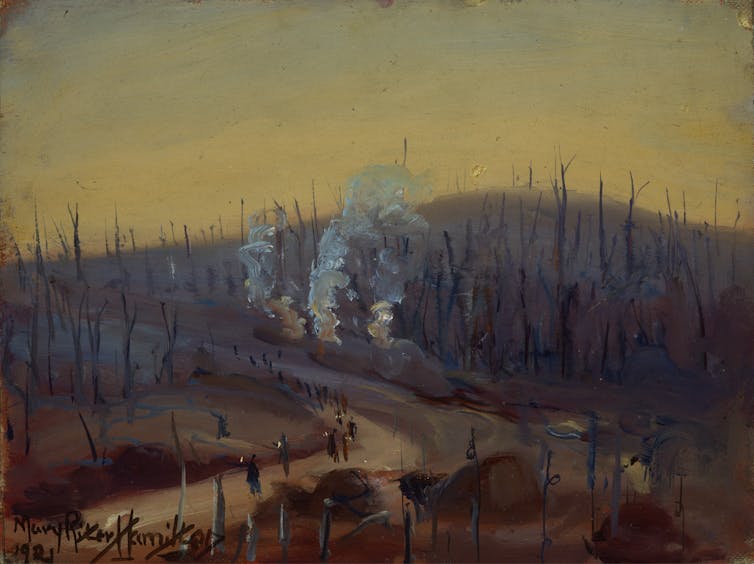
Painter and witness
As a witness of mass graves and human remains, Hamilton responded with a painting style that made viewers see and feel her deeply felt and ultimately traumatic encounters, rendered in vivid colours, spontaneous brushstrokes and tumultuous landscapes.
Hamilton transgressed the rules of both gender and art in her day. Hamilton first embraced her artistic vocation after her husband’s sudden death when she was 26.

In early 1919, she was commissioned by the war amputees club of British Columbia, who paid for Hamilton’s trip overseas, and likely for two shipments of her paintings back to Vancouver. The club reproduced her paintings in colour in their magazine but discontinued their support after one year. Hamilton continued while using up her personal resources and relying on sporadic support from a female patron in Victoria, B.C.
When Hamilton left Canada, she was at the height of a brilliant career, at that time much more recognized than painter Emily Carr.
Non-official scenes
Artists with the Canadian War Memorial Fund made brief sketching trips to battlefields and then prepared polished and monumental paintings in their London and Paris studios. As art historian Laura Brandon has shown, artists such as Arthur Lismer and Frederick Varley used photographs, which they combined with their own experience to compose war paintings as amalgamated scenes. The most famous of these Canadian War Memorial-commissioned paintings, Richard Jack’s The Second Battle of Ypres, reconstructed dramatic combat by using unrealistic 19th-century war art conventions, although the artist had visited the battlefield after the fight.
Hamilton, by contrast, transgressed official war painting norms to pioneer her own visceral style that blurred boundaries between documentary realism and esthetic urgency. Many of her works exhibit a haunting blankness, recalling the missing soldiers. She also painted individual soldiers’ marked graves, as well as mass graves where entire regiments had perished. In so doing, she insisted on remembering and mourning each individual loss.
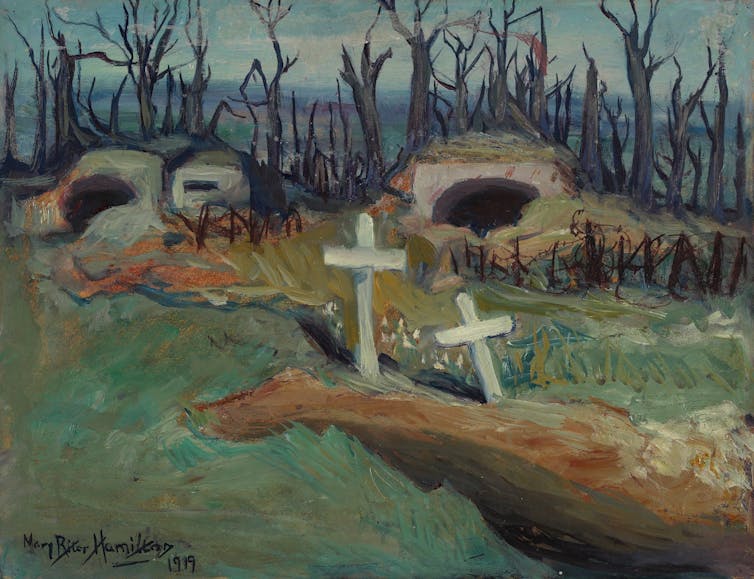
She painted on small canvases or pieces of plywood or paper while trekking through collapsing trenches and swamps en route to remote areas. Her work can be seen as a part of what political theorist Michal Givoni has identified as a 20th-century shift towards mobilizing acts of witnessing as a vocation by showing difficult truths in public.
Among the handful of women who painted the First World War, Hamilton stands out for the magnitude of her work, the length of her stay in the battlefields and her empathic esthetic achievements.
Today, we have witnessed disturbing images of mass graves during the COVID-19 pandemic in the same time that our society is reckoning with what it means to make ethical choices as we confront connections between systemic inequities, violence and historical trauma. How we think about and understand Hamilton’s courageous, determined and perilous engagement of mass death is more important than ever.
Startling perspective
In Memorial for the Second Canadian Division in a Mine Crater Near Neuville St. Vaast (circa 1920) Hamilton visualizes the shocking decimation of an entire regiment with an alarmingly deep hole, whose cutaway view gives viewers a startling, open perspective.
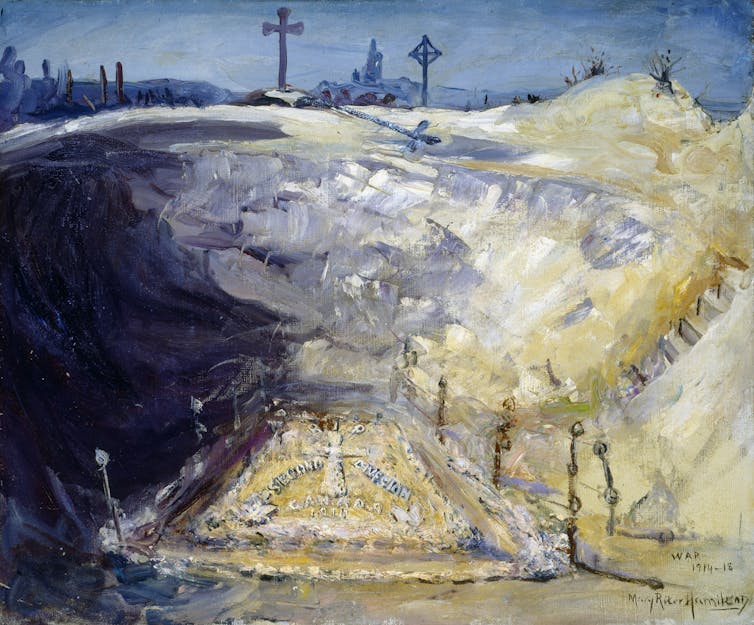
Also concerned with survivors, she recorded scenes of reconstruction, as in Cloth Hall, Ypres – Market Day (1920). This showed grieving family members at a distance and depicted signs of hope and new life.
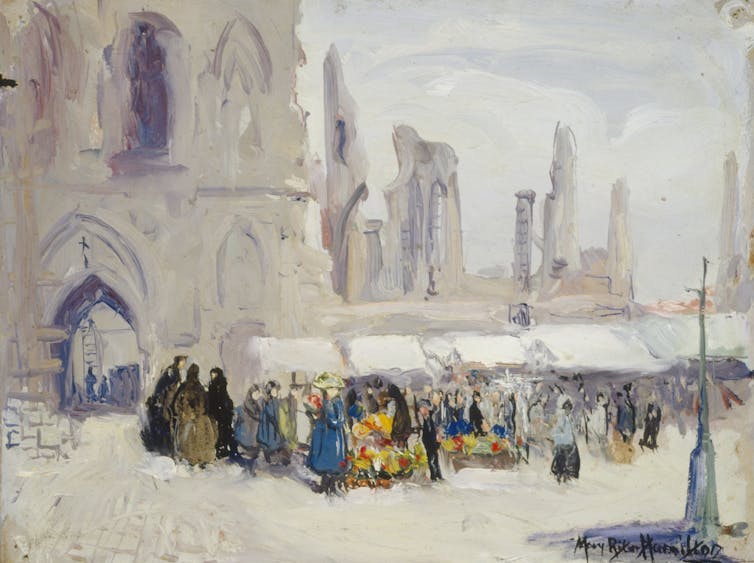
On her expedition, Hamilton overnighted in war-torn Nissen huts erected for military shelter and storage or other makeshift shelters. By 1920, her war studios included a bombed-out attic in Arras, France. She often ground her colours on the battlefield. She lived in extreme poverty, often starving and putting her life in danger.
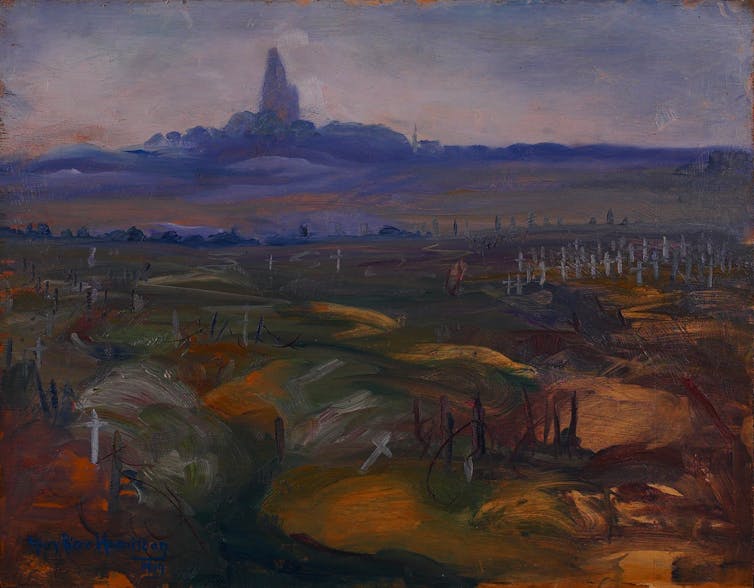
Recognizing her work
Art historians Robert Amos and Ash Prakash have begun to document Hamilton’s important pre-war contributions to Canadian impressionism.
Beginning in 1989, historian Angela Davis, with art historian Sarah McKinnon,
about Hamilton.For Remembrance Day this year, Canada Post has dedicated a stamp to Hamilton’s memory, featuring her 1919 painting Trenches on the Somme in which scarlet poppies grow along white chalk walls of the trench. The painting exhibits her trademark style, which often puts the viewer inside a trench.

Hamilton brought home more than 320 battlefield works painted in oil, or drawn in pencil, charcoal or pastel, along with etchings. She donated 227 to the Dominion Archives (today Library and Archives Canada).
In 1922, Hamilton was awarded one of France’s highest honours, the Ordre des Palmes académiques.
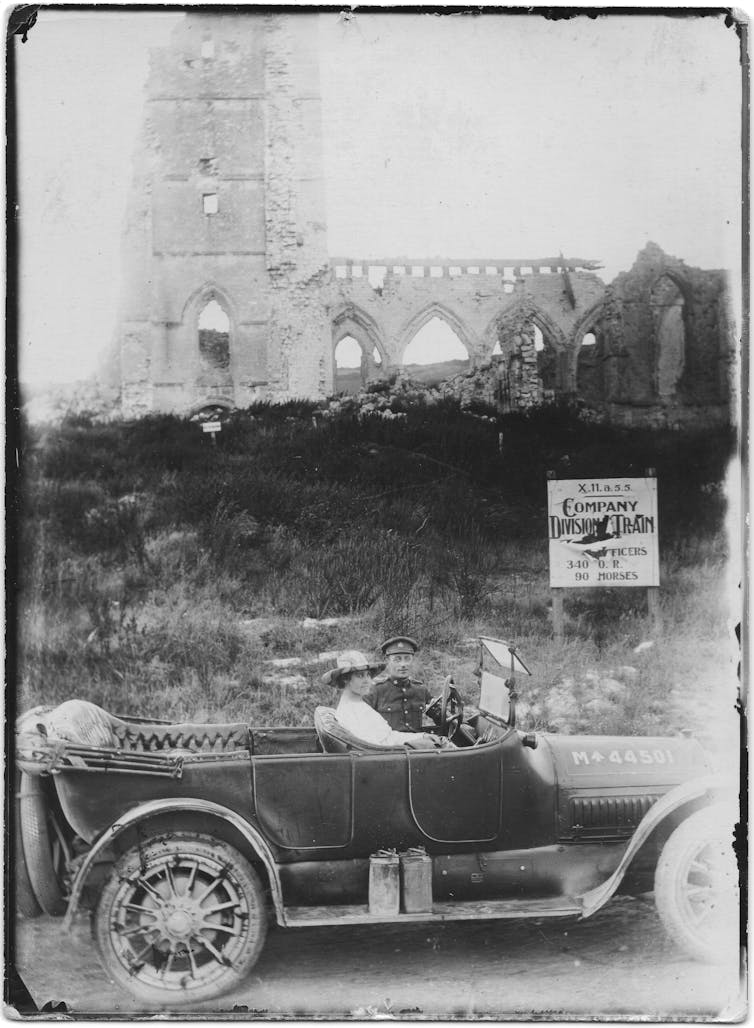
Life and legacy
Hamilton’s life and legacy leaves us much to reflect on today. As an artist who embraced witnessing as a vocation, she broke barriers and insisted upon artistically rendering what she saw with candour. Her perception and embodied art practice also left a unique record of the physical and moral devastation of war, both in her art and in her own life.
As a woman artist travelling through battlefields, she experienced mobility, articulated a vision of empathy and contributed to a public record of the war. Yet how she engaged with her craft and what she saw took a toll on her health and ultimately curtailed her career as a painter. She suffered from post-traumatic stress and a major mental breakdown and other health problems following her expedition. War painting would mark her for life.
Hamilton summed up her achievement with understatement: “Yes, it was like living in a graveyard … but I felt this was a duty that someone must do, and I thought I would try to do it.”
Irene Gammel, Professor & Director, MLC Research Centre and Gallery, Ryerson University
This article is republished from The Conversation under a Creative Commons license. Read the original article.
US election 2020 results: Biden crosses 270 electoral votes, projected to be winner
Sunday, 08 November 2020 12:21 Written by Michael AbiodunDemocratic Party candidate, Joe Biden, is now projected to have 284 Electoral College votes on Saturday.
This is beyond the 270 threshold needed to clinch the United States presidential seat.
Biden was projected to have surpassed the 270 electoral vote-threshold after the AP called Pennsylvania in his favour.
His running mate, Kamala Harris, has made history as the first woman elected as Vice President of the US
This year, votes took longer to count, due to the high increase of mail-in ballots which many Americans chose to use amidst the COVID-19 pandemic.
US President Donald Trump’s campaign has vowed to challenge the result, particularly in the states of Georgia, Pennsylvania, Arizona and Michigan.
Donald Trump's 'supporter' storms press conference to accuse Joe Biden of 'stealing the election' (video)
Thursday, 05 November 2020 08:58 Written by lindaikejiblog While the US presidential election results are still being counted with Joe Biden leading so far, a 'supporter' of Donald Trump stormed a press conference in Nevada to accuse the Democrat of 'stealing the election.' 'The Biden crime family is stealing the election!' he yelled. 'The media is covering it up. We won our freedom for the world. Give us our freedom Joe Biden!
Election officials were updating reporters on their progress in counting the votes when a man in a 'BBQ, beer, freedom' t-shirt interrupted them to angrily rant about Joe Biden.
'Joe Biden is covering up this election! He's stealing it', he added before walking off.
A second Trump term? Or a Biden presidency? What it means for Canada
Thursday, 05 November 2020 01:56 Written by theconversation 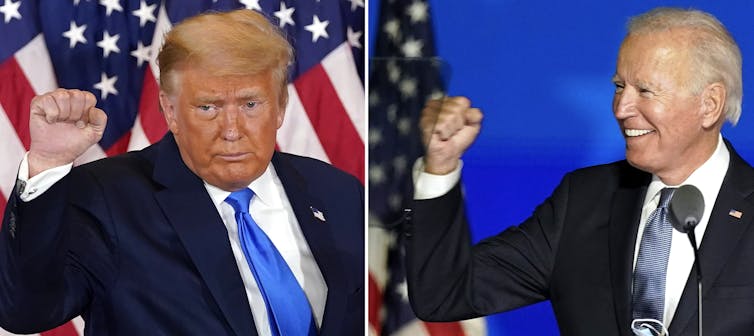
Thomas Klassen, York University, Canada
After a surreal election campaign in the midst of a pandemic, we’re still not sure of the outcome — either Donald Trump won a second term, or Joe Biden will become the next president. Although pre-election polls showed Trump heading for certain defeat, he once again defied pollsters.
Viewed by many as a referendum on Trump’s first term, and indeed on the man himself, the election was one of the most tumultuous in American history. The outcome is still not clear because ballots are still being counted in key battleground states.
Like Hillary Clinton four years ago, Joe Biden positioned himself as the keeper of former president Barack Obama’s progressive ideology. In contrast, Trump promised an “America First” platform of limiting immigration and protecting United States trade interests — a stance that has included, at times, taking aim at Canada, the country’s closest trading partner.
Read more: Canada needs to see the U.S. and its trade motives clearly
What’s ahead for Canada?
For Canadians, a Trump victory would essentially mean more of the same but perhaps at a lower decibel level.
Justin Trudeau has managed his relationship with Trump as well as anyone could. Pipelines, steel, aluminum, agriculture and forestry products will continue to be on Trump’s agenda and will be trade irritants between the two countries.
The reality is that Canadian interests — whether on trade, global climate change, foreign affairs or other matters — don’t align with America’s, regardless of the president in power.
A President Biden, on the other hand, will mean a period of uncertainty as a new administration takes charge. But if Trump remains in power, there will be little ambiguity in the Canada-U.S. relationship.
Canada and the battleground states
As in 2016, this election will be decided by a trio of battleground states — Pennsylvania, Michigan, Wisconsin. The ballots are still being counted, but Biden has been declared the winner in Wisconsin, though Trump is demanding a recount. Trump won all three states in 2016, which helped carry him to victory.
These swing states are critical because they routinely shift between voting for the Democratic presidential nominee and the Republican nominee. Most states vote for the same party election after election. California, for example, with its 55 electoral college votes (more than one-fifth all the electoral votes needed to become president), has overwhelmingly voted Democrat for decades. With little likelihood of that changing, both Biden and Trump did almost no campaigning in California.
In contrast, Ohio — one of the battleground states won handily by Trump this election — sways back and forth between Democrats and Republicans. And since 1944, the state has only once voted for the losing candidate, choosing Richard Nixon over John F. Kennedy in 1960.

These battleground states — some of them lining the Canadian border — played an outsized role in this campaign. Trump and Biden did most of their campaigning in these states during the past months knowing that every vote they could obtain counted.
Trump’s “America First” policies resonate with voters along the northern border, some living so close to Canada that they may imagine the loss of their assembly plant or farm to a foreign entity, as outlandish and unlikely as that may seem to Canadians.
Perhaps one day Trudeau will have the opportunity to remind Trump, if he wins re-election, that his second term was in large measure due to support from the states with the closest economic and cultural ties to Canada.
Trump’s imprint on the U.S.
Beyond his populist style, Trump will have four more years to leave deep marks on America should he win a second term. He is the only person ever elected president without prior government or military experience. He is the oldest person to serve as president.
During his tenure, three Supreme Court justices were confirmed, reshaping the court for a generation. Barack Obama, George W. Bush and Bill Clinton only had two justices confirmed during their eight-year terms. Likely more appointments could occur during a second term.
The question for Trump is whether to seek out new avenues to leave a legacy, or to solidify the shifts he has engineered so far. If the former, then working more closely with Canada on matters such as trade disputes with China or immigration policy would be reasonable options. This could certainly happen under a Biden presidency — Obama and Trudeau had a “bromance,” and Biden could pick up where Obama left off in terms of a positive working relationship with his Canadian counterpart.

Regardless, if he’s won re-election, Trump — perhaps for the first time in his life — may feel he has nothing more to prove. This may create openings for policy innovation. Canadian policy-makers would be wise to seek to present some of these to the White House, such as on tourism and regional development that are win-win for Canada and the U.S.
Biden and the Democrats
In some ways, Biden was an odd choice as standard bearer for Democrats eager to portray themselves as a party of new ideas and change. The last five Democratic presidents — Kennedy, Lyndon Johnson, Jimmy Carter, Bill Clinton and Obama — were, on average, 30 years younger when they took office than Biden.
Many in Canada prefer Biden to Trump. Democratic presidents have historically had better personal relationships with Liberal prime ministers than Republican presidents have. A Biden presidency holds the promise that Canada could be treated with more respect and care, even if the underlying disagreements remain.

Kamala Harris is also a bright spot for the U.S.-Canada relationship.
Regardless of whether Biden or Trump is the winner, she’ll have an excellent opportunity to become the Democratic presidential nominee in four years (should a President Biden opt not to run again). Having spent her teenage years in Montréal, Canadians dismayed at the prospect of four more years of Trump can seek solace that the next president may be someone with a personal Canadian connection.![]()
Thomas Klassen, Professor, School of Public Policy and Administration, York University, Canada
This article is republished from The Conversation under a Creative Commons license. Read the original article.
Popular News
Trump has made America nostalgic again for a past that never existed
Thursday, 05 November 2020 01:49 Written by theconversation 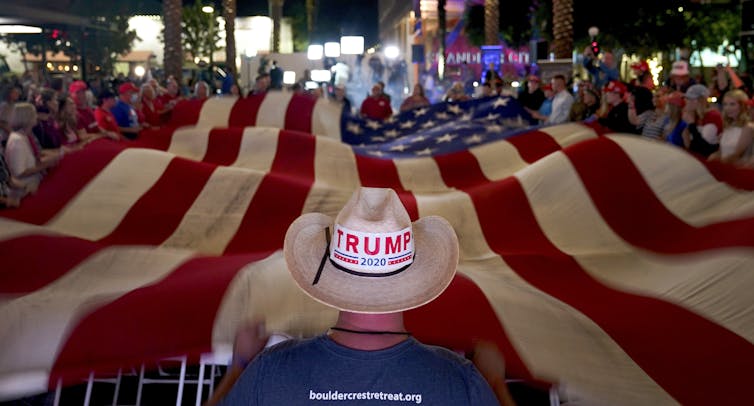
Cheryl Thompson, Ryerson University
As a Canadian, I sit at the edge of my seat every election night in America.
Even though it is not my country, like many, I feel the magnitude of what’s at stake in a country increasingly divided over issues of race, gender, the economy and the coronavirus pandemic.
While this has been the narrative of the past four years, America has always been a nation divided. This division was thoroughly examined in the New York Times 1619 Project, which sought to reframe the country’s history by placing plantation slavery and the African American experience at the centre of American history.
Despite historical facts, what has made the Trump era unique in its divisiveness is the way in which his presidency has been marked by a stark failure to disavow white supremacy while discrediting African American attempts to reclaim their place in American history. He condemned the 1619 Project while paradoxically claiming that he has done “more for the African American community than any president with the exception of Abraham Lincoln.”
While we may not know the winner of the election for some time, what was clear on election night is that Trump did better than pollsters predicted. Why was this race so close?
Different ideologies
Trump and Biden could not be more different in terms of ideology. But when it comes to nostalgia, both candidates relied on a similar notion of returning America to a different time.
For Trump, “Make America Great Again” has not only functioned as a political slogan, it has also morphed into a battle cry for his followers who yearn for a past that has never existed.
Through repeated invocations, the slogan is not only a reference to the past but also a “structure of feeling” — a term cultural theorist Raymond Williams coined in the 1950s. The term describes the paradox between the reality of people’s lived experiences — with its intangible and undefined parts of cultural life — and the official, material and defined forms of society.
In other words, MAGA has nothing to do with policy — hence why Trump’s re-election campaign had undefined policy objectives — but everything to do with how and what his followers “feel” and think about MAGA.
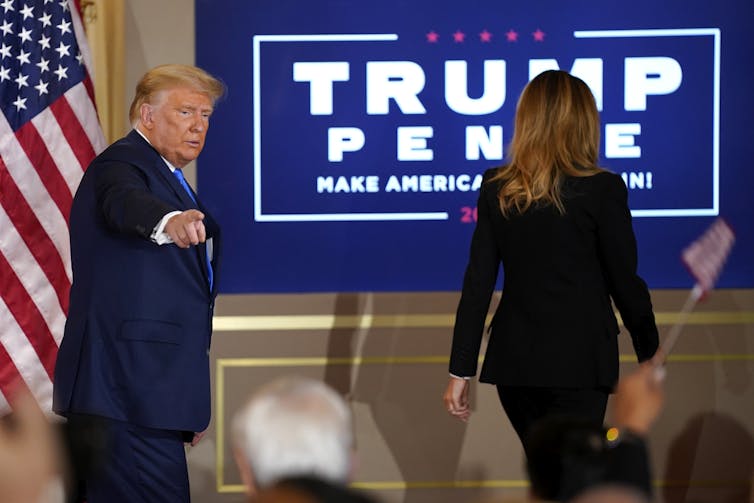
Biden also has a brand of nostalgia and has played on the trope of an industrial America of yesteryear, where people work hard, love their families as they do their neighbours. It’s a place where “honest Joe” can acknowledge that some of the neo-liberal policies of the Democratic Party that he endorsed, including the 1994 crime bill, might have harmed African Americans — the very people whose votes he needed — but for which he, unlike Trump, is at least able to apologize and show some modicum of empathy.
Biden’s selling point, then, was that “at least” he cares. Was that enough to win over African Americans?
Black men iffy about Kamala Harris
Even with Kamala Harris, a Black woman (who also identifies as South Asian) on the ticket, African Americans have been divided about her loyalty.
While Black women were excited about Biden’s pick, many Black men were not. That wasn’t because of policy decisions as a California senator, but because of her former job as California’s attorney general, and before that, as district attorney of San Francisco where, under her tenure, Black people made up less than eight per cent of the city’s population but accounted for more than 40 per cent of police arrests.
So unlike the narrative of community organizing and activism that was attached to Barack Obama during his 2008 presidential run, a narrative that seemed to supersede his work as a senator, Harris’s past has seemingly overshadowed her Senate work, even as her votes have been in aid of Black America.
The closeness of the 2020 election has much to do with the way in which both Trump and Biden have invoked an imagined past, a narrative that suggests America needs to perpetually look back instead of looking forward.
Looking backwards
Obama’s 2008 slogans — “Change we can believe in” and the chant “Yes We Can” — were so powerful because they projected an air of possibility about the future, that things could improve and that voters had the power to make it happen.
Trump’s “Make America Great Again” and Biden’s “Battle for the Soul of America” have nothing to do with the voters or their ability to create a future; instead, both slogans send the same message — there was a time in America where things worked, where the nation was untainted by division, and that it must return to.
This act of forgetting reality by clinging to a fictive, golden-days past is reminiscent of the title-track of the 1973 film The Way We Were, starring Barbra Streisand and Robert Redford. The song, performed by Streisand, was a huge hit, No. 1 on the Billboard Year-End Hot 100 singles in 1974.
Most people don’t remember that Gladys Knight & The Pips also released an R&B cover of the same song in 1974. In the collective memory of The Way We Were, the song belongs to Streisand; it’s hard to even imagine anyone else singing that song. In other words, people forget details, but what gets remembered is the iconic. Streisand is an icon. (Knight’s an icon in her own right, but primarily among African Americans.)
Trump is iconic
Similarly, Trump is an iconic figure whose fan worship has managed to literally trump the Republican Party itself. He has convinced his loyal following to cling to the past because it was simpler then, and it gives people a chance to live out that simplicity — however fictional Democrats believe it to be — over and over again.
Our memories of the past do not matter; what matters in the Trump era is the rewriting of every line of actual historical fact. Biden has relied on empathy and sentiment to win back the presidency, to bring back a kind America with his numerous folksy “Bidenisms” while Trump has done what nobody thought was possible — he has confused the citizenry to the point where many likely can’t remember what the U.S. was like before 2016.
While Trump likes to evoke Lincoln’s name, it was Lincoln who famously said: “A house divided against itself cannot stand.”
America is divided. But the question is, when the dust clears and the ballots are all counted, will it still aspire to become the nation it so desperately tells itself (and the world) that it can be?![]()
Cheryl Thompson, Assistant Professor, Creative Industries, Ryerson University
This article is republished from The Conversation under a Creative Commons license. Read the original article.
US election 2020: live count of the race to the White House and state-by-state breakdown of Senate races
Wednesday, 04 November 2020 11:46 Written by theconversationThe US has already seen record early voting in the presidential election, with more than 100 million people casting ballots before election day.
Now, the counting begins. With a variety of differences in when early votes and mail-in ballots can be tallied, as well as different closure times for polling places, the results will trickle in throughout the day (and evening).
We’ll be regularly updating this article as data becomes available and relying on The Associated Press to call individual state races.
There are plenty of other races being contested around the country, including, most importantly, the Senate. More than a third of the Senate seats (35 out of 100) are being contested — and the Democrats have a good chance of taking back control from the Republicans.
Of the 35 seats, the Republicans are defending 23 and the Democrats 12. The Democrats need a net gain of three seats to control the Senate if Joe Biden wins the presidency, and a net gain of four seats if Donald Trump is re-elected.
![]()
Wes Mountain, Multimedia Editor, The Conversation
This article is republished from The Conversation under a Creative Commons license. Read the original article.
U.S. election results may suggest ethics no longer matter ... just like in Canada
Wednesday, 04 November 2020 11:45 Written by theconversation 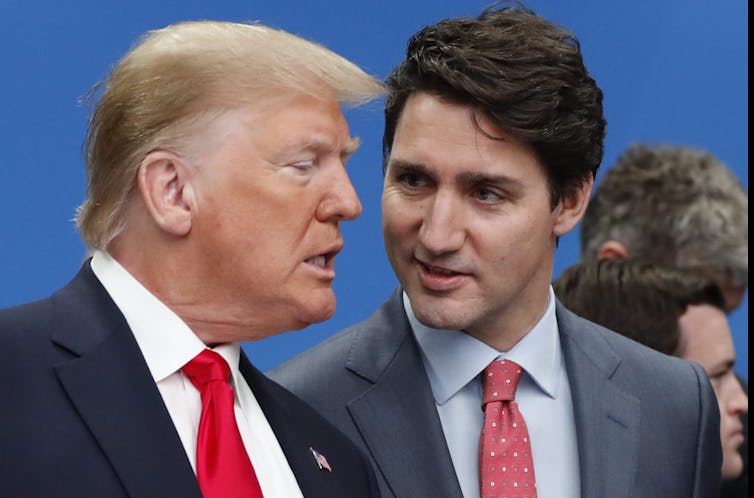
Ako Ufodike, York University, Canada
During Donald Trump’s first term, there have been a record 30 congressional, criminal or state investigations into his affairs, compared to four for his predecessor, Barack Obama, over his two terms.
It’s impossible to dismiss all of these investigations as political witch-hunts. In fact, when Trump took office in 2016, only 33 per cent of Americans believed that he was honest — a number that has remained consistent. Ironically, the president to whom Trump has most often compared himself is “Honest Abe” Lincoln, likely because of his assumption that honesty matters to voters.
But does it?
While the outcome of the U.S. election may not be known for days, one thing is clear — Trump outperformed pollster predictions once again in 2020.
Conventionally, voters enforce political accountability. But Trump won the 2016 election without being perceived as honest or trustworthy, and the Republican Party actually attained its most favourable rating since 2005 in January 2020 when the Republican-led Senate acquitted the recently impeached Trump.
That raises questions about whether ethics still matter in politics. Do voters have an increasing tolerance for political misconduct or do they just have other electoral priorities?
Canada not immune
As Canadians, we like to think our politics are somehow less tainted or controversial than American politics, but these questions resonate equally in Canada.
Prime Minister Justin Trudeau was investigated three times between 2015 and 2019 for various ethical misconduct related to the SNC-Lavalin affair and his vacation visits to the Aga Khan’s private island.
Read more: The SNC-Lavalin affair and the politics of prosecution
Canada’s ethics commissioner found Trudeau guilty of contravening conflict-of-interest laws in both cases. Trudeau’s predecessor, Stephen Harper, faced no investigations during his eight years in office. Clearly, it’s appropriate to wonder about the diminishing role of ethics in our choice of national leaders in Canada as well.
But let’s look back to November 2019 in the United States for a moment: Trump wanted to avoid the public spectacle of impeachment proceedings because of concerns about their impact on public perception.
The administration actively sought to block the testimony of anyone with first-hand knowledge of the events, and Trump’s legal team claimed immunity for all top presidential aides.
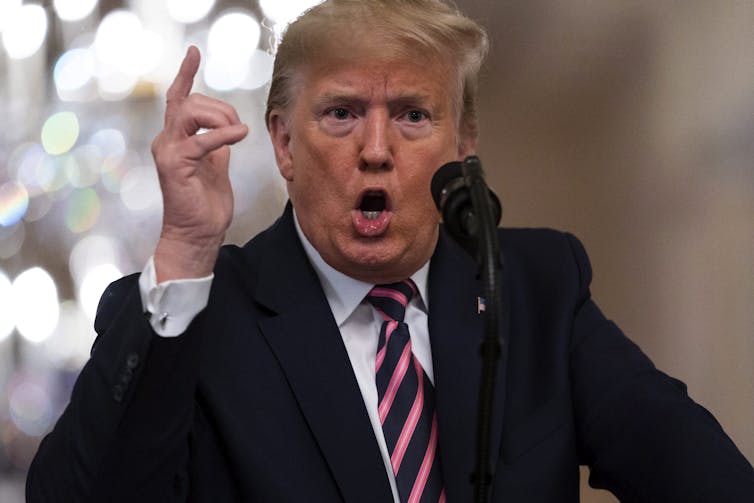
It seems that Trump was unnecessarily worried about public perception. In the November and December Gallup polls before he was impeached on Dec. 19, 2019, Trump’s average approval was 44 per cent. In the two polls following impeachment, his average approval rating increased to 47 per cent, and in two more polls after the Senate acquittal, his approval held steady at 46 per cent.
What does matter to voters?
If ethics don’t matter in the choice of political leaders anymore, what does? According to a recent Gallup poll, the most important issue in the 2020 U.S. election was health care. Unsurprisingly, voters also identified the economy as one of the top five issues in the election. Health care, the economy and education are the only common three of the top five issues in both the 2016 and 2020 elections.
The COVID-19 pandemic have exacerbated concerns over health care, sending it from third place in 2016 to first place in 2020 — and that was the largest hurdle for Trump’s campaign this year, not the public’s perception of his ethics or honesty.
Canadians likewise identified health care and the economy as top concerns in both the 2019 and 2015 federal elections. During the last election in 2019, voters cited the cost of living, health care and climate change as three of the top five issues.
Accountability has gone from being a top concern for 11.4 per cent of respondents ahead of the Canadian 2011 election to 7.1 per cent in 2015 and six per cent in the 2019 election in spite of the SNC-Lavalin investigations.
Trudeau’s re-election
Like Trump’s concerns about impeachment, Trudeau’s concerns about the electoral costs of the SNC-Lavalin affair were unfounded. Furthermore, Trudeau is notably the first and only Canadian prime minister to break a federal conflict-of-interest statute in relation to his Aga Khan trips — and yet he got re-elected to a second term, albeit with a minority government.
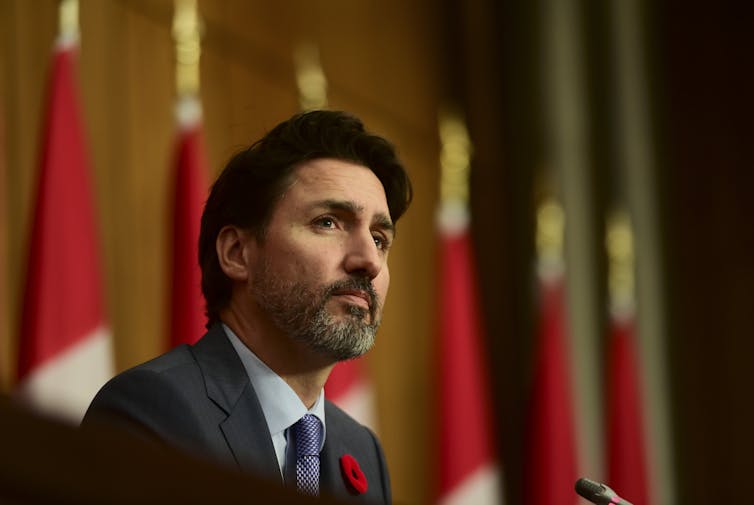
As the SNC-Lavalin affair showed, Trudeau, like Trump, prefers that certain details of his dealings not be played out in public.
The office of the Ethics Commissioner, in its investigation of Trudeau’s conduct related to SNC-Lavalin, reported that the government denied it access to cabinet confidences, suppressed witness testimony and therefore prevented the office “from looking over the entire body of evidence.”
Despite the government’s efforts to limit the scope of the investigation, the commissioner concluded that Trudeau contravened Section 9 of Conflict of Interest Act.
More recently, the WE Charity investigation, which kicked off Trudeau’s fifth year as prime minister, has superseded the SNC-Lavalin affair.
Read more: Why Trudeau’s self-serving prorogation of Parliament should be Canada’s last
Do Canadians care about ethics?
How will Canadians rank ethics and accountability in the next election? Will we care about the ethics laws that our leaders have violated, or, like in the United States, will the pandemic amplify concerns over health care and economic recovery, overshadowing ethics?
If the 2020 U.S. election is any indication, focusing on the economy and health care, rather than past or present ethics investigations, will resonate more broadly with voters. For Canadian politicians, environmental policies and platforms will be a close third.
Unethical politicians may be off the hook for bad behaviour as voters prove again that they’re willing to look the other way.![]()
Ako Ufodike, Assistant Professor, York University, Canada
This article is republished from The Conversation under a Creative Commons license. Read the original article.
This Halloween, witches are casting spells to defeat Trump and #WitchTheVote in the U.S. election
Tuesday, 03 November 2020 04:44 Written by theconversation 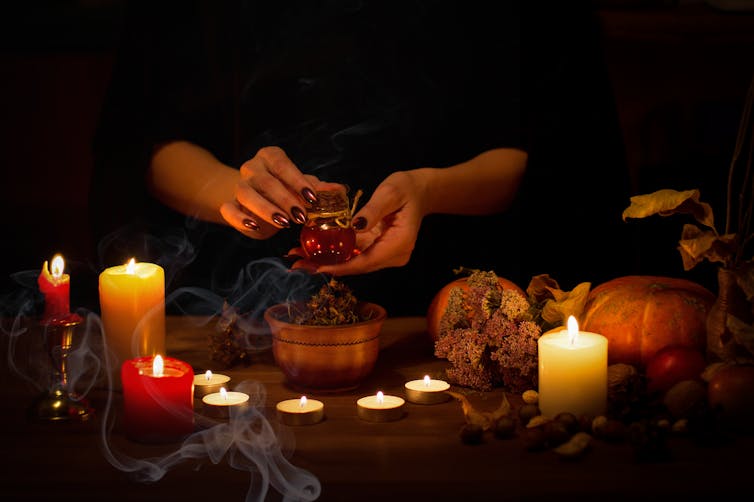
Jessalynn Keller, University of Calgary and Alora Paulsen Mulvey, University of Calgary
This Halloween, the witches are coming — to the ballot box.
Using the hashtag #WitchTheVote, witch-identified folks are encouraging others who have an interest in the occult to get informed about political candidates and cast their vote in the U.S. presidential election Nov. 3.
Originally launched by a group of witches from Salem, Mass., during the lead-up to the 2018 midterm elections, #WitchTheVote is a cross-media initiative that identifies and promotes — as one witch tells us — “witch-worthy” political candidates: those who are progressive and social justice oriented. It’s fitting political activism in a town known for the Salem witch trials and contemporary witch tourism.
Witching movements
More than a hashtag, #WitchTheVote is also, according to the group, a “collective intersectional effort to direct our magic towards electing candidates who will push our country and our planet forward into the witch utopia we all envision.”
Here, intersectional feminist politics work alongside magic and creative media production to engage in political activism that includes advocacy around issues like affordable housing, reproductive rights and #BlackLivesMatter. #WitchTheVote runs a regular podcast and has also made and distributed zines with information for prospective voters, including how to register to vote and how to check to ensure your mail-in ballot was received.
This collective effort illustrates the ways in which “magical resistance” has become a popular, women-led form of mediated, political activism since the election of Donald Trump in 2016.
The resurgence of the witch
#WitchTheVote is situated within a resurgence of witches in popular culture over the past four years. Between Netflix’s teen drama The Chilling Adventures of Sabrina, beauty retailer Sephora’s Starter Witch Kit (which was eventually removed due to backlash), the revival of the cult classics teen witch movie The Craft and TikTok spell trends, the witch is having a cultural moment.
Read more: Dressed to kill: 6 ways horror folklore is fashioned in the movies
Books such as Pam Grossman’s Waking the Witch (2019) have attracted widespread media attention, while public interest in astrology and tarot readings has also grown.
Esthetically, witchcraft and mysticism circulate easily on visual social media platforms such as Instagram and TikTok, where colourful crystals and elaborate altars make for beautiful photos and videos. From a branding perspective, the witch’s popularity makes sense within a larger cultural interest in spirituality, wellness and mysticism.
But there is also a case to be made for the very political nature of the witch. The archetype of the witch has a historical relationship with feminist activism. As an unruly figure and threat to the patriarchy, the witch is resistant, and has been used in feminist protest since the 1960s.
Read more: Sirens, hags and rebels: Halloween witches draw on the history of women’s power
At a moment of regressive politics marked by a resurgence of white supremacy, xenophobia and anti-feminist sentiments, coupled with the uncertainty of a global pandemic and the looming climate crisis, it is unsurprising that women and other marginalized folks are turning to witchcraft as a way to make sense of — and act upon — our current political, social and economic milieu.
The digital coven
It is perhaps the collectivist sentiment of contemporary witchcraft — belonging to something bigger, together — that is appealing. Indeed, #WitchTheVote’s mandate as a “collective intersectional effort” suggests the force of doing something together, yet attuned to the different experiences, including those related to race, class, sexuality, age and ability, that participants may face.
And while not the only tool for mobilizing a collective, technology has become a significant connector for covens in recent years. Social media platforms, in particular, provide what some witches refer to as “globally accessible magic.”
By embracing technology while recognizing its limitations and inherent oppressions, witches are engaging in new rituals with the intent of keeping their channels clear for maximum revolutionary power on an individual and collective level.
For example, upon Donald Trump’s election in 2016, witches began a monthly ritual of casting a spell to “bind” Trump, preventing him from pursuing his agenda that many witches believe to be harmful. Some witches used platforms such as Facebook Messenger and Twitter to connect with other spell-casting witches at a designated time each month, ensuring that the “mass energy of the participants” is harnessed.
Spells and rites
Historically, spells often required very little in terms of commercial goods. Instead, witches relied on basic household items like candles and feminized rituals such as sweeping to engage in witchcraft. #WitchTheVote’s “A Multi-tasking Spell for Mutual Aid During COVID-19” lists a pen, paper and “anything else that makes you feel like a witch” as necessary materials. Other spells recommend candles of any size and colour and dirt from your backyard.
The emphasis is not on the materials themselves, but instead engaging with rituals that help witches feel empowered through practices that provide a sense of routine, stability and purpose in unpredictable times.
In the digital age, using the Internet as another avenue to practice witchcraft seems like a natural extension to the tradition of making do with the resources available to you. We may even think of emojis, shares, likes and retweets as possible technologies of magic when used with energetic intention to manifest social change.
And these practices are extensions of activist use of technologies such as feminist listservs, e-zines, chatrooms, homepages, feminist blogs and now, social media.
Casting spells and votes
In a political, cultural and economic moment in which many people feel a sense of hopelessness about the future, #WitchTheVote encourages activists to ground themselves through ritual and magical resistance.
They remind us of girls’ and women’s lengthy history in subverting repressive politics through focused collective action. In casting their votes along with their digital coven on Nov. 3, Salem’s activist witches hope to #WitchTheVote, one ballot at a time.
Jessalynn Keller, Associate Professor in Critical Media Studies, University of Calgary and Alora Paulsen Mulvey, PhD Student, Department of Communication, Media and Film, University of Calgary
This article is republished from The Conversation under a Creative Commons license. Read the original article.





